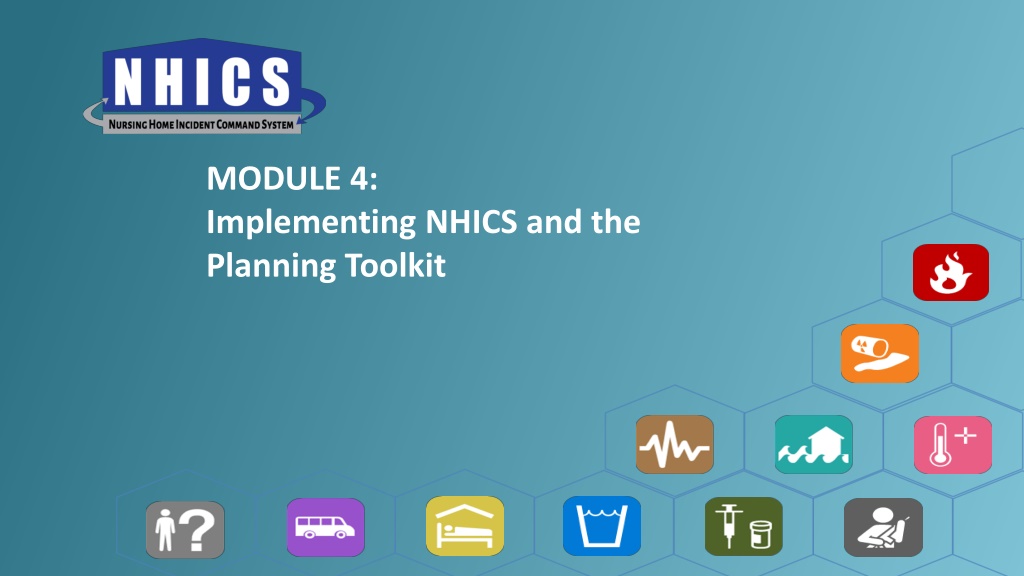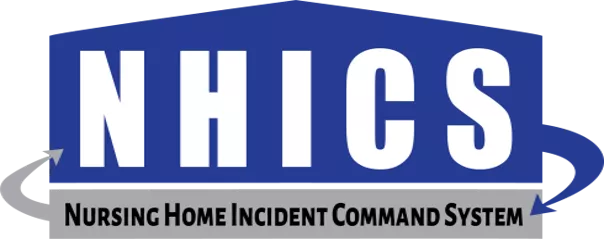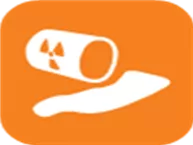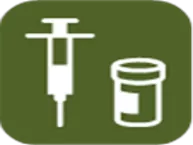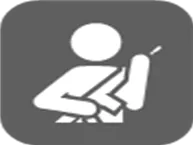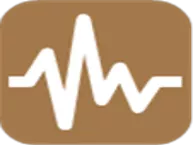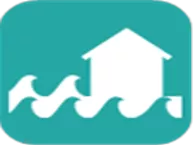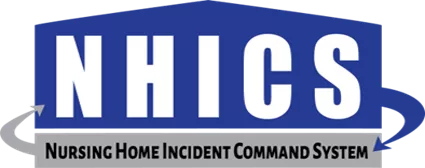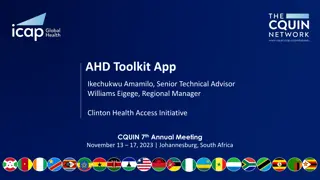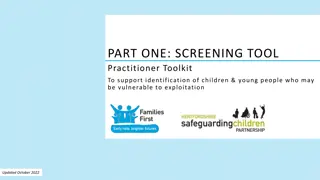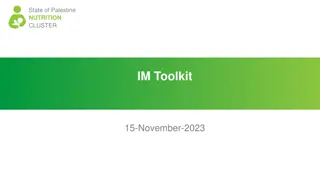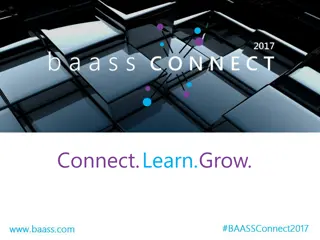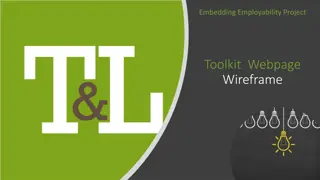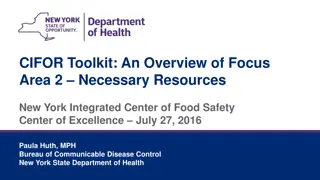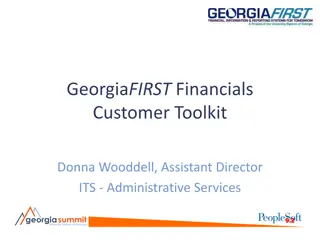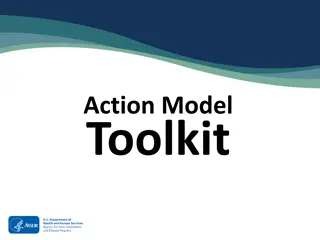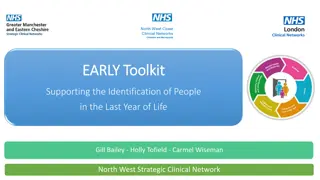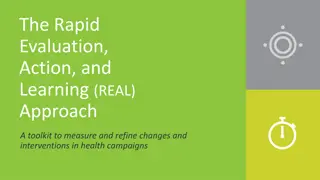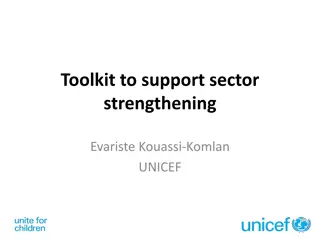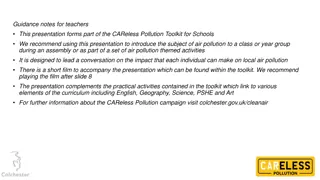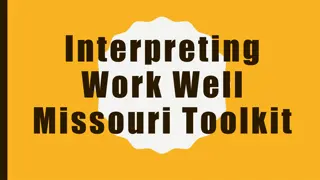Implementing NHICS and Planning Toolkit Overview
Module 4 provides a detailed overview of implementing NHICS (National Incident Management System at a Nursing Home) and utilizing the Planning Toolkit. It covers key objectives, the 2017 Planning Toolkit components, the All Hazards Incident Planning Guide (IPG), NHICS Glossary, and the 10 basic steps for NHICS implementation, including important considerations and participant involvement.
Uploaded on Sep 10, 2024 | 2 Views
Download Presentation

Please find below an Image/Link to download the presentation.
The content on the website is provided AS IS for your information and personal use only. It may not be sold, licensed, or shared on other websites without obtaining consent from the author.If you encounter any issues during the download, it is possible that the publisher has removed the file from their server.
You are allowed to download the files provided on this website for personal or commercial use, subject to the condition that they are used lawfully. All files are the property of their respective owners.
The content on the website is provided AS IS for your information and personal use only. It may not be sold, licensed, or shared on other websites without obtaining consent from the author.
E N D
Presentation Transcript
MODULE 4: Implementing NHICS and the Planning Toolkit
Objectives - Module 4 Familiarize yourself with the NHICS planning tools Learn the 10 steps for implementing NHICS at your facility
Planning Toolkit The 2017 Planning Toolkit includes the: Streamlined All Hazards Incident Planning Guide (IPG) Replaces incident-specific IPGs NHICS Glossary
All Hazards Incident Planning Guide (IPG) The All Hazards IPG is: Used for planning and discussion; are modifications necessary for your facility? Organized by four phases of emergency management: Mitigation Preparedness Immediate and Intermediate Response Extended Response and System Recovery
All Hazards Incident Planning Guide (IPG) An All Hazards approach to emergency management calls for a nursing home to work toward: Hazard prevention while at the same time preparing for the emergencies that may occur at any time without warning May be customized to your facility s needs
Glossary The NHICS Glossary is: A quick reference guide for key terms Arranged alphabetically Includes acronyms used in the NHICS Guidebook and Toolkit
NHICS Implementation NHICS can be implemented in 10 basic steps
Step 1 Getting Started Appoint a person to lead implementation Convene a planning workgroup Read the NHICS Guidebook Review Toolkit materials Complete NHICS training Outline necessary activities Establish the final approval process
Step 1 Getting Started Set up a work schedule Consider developing an implementation/ training program with other area nursing homes for standardization and mutual aid assistance Invite public safety, public health, EMS and emergency management officials to participate as appropriate
Step 2 Determine your IMT Review the NHICS IMT chart Determine who is appropriate for each role Remember that a specific person may not be available when the emergency strikes Ideally, select multiple persons for each position Limit the number of times a specific person can be listed
Step 3 Revise Job Action Sheets if necessary JASs are available for each position on your IMT Review each JAS to ensure consistency with your facility s policies and procedures Make changes as needed to each JAS, but try to limit changes to preserve standardization
Step 3 Revise the Job Action Sheets Once any adjustments to the JASs are completed, immediately publish the final JASs: Include in the Emergency Operations Plan (EOP) Put JASs on computers that can be accessed in the Nursing Home Command Center and other key areas Be sure that printed JASs are readily accessible in the Nursing Home Command Center in case computers become unavailable Put JASs into pocket of the NHICS Command Vests
Step 4 Review the NHICS Forms Review the NHICS Forms: Make limited changes if necessary (to maintain standardization) Add additional forms you feel may be needed or easier to use based on your facility s policies or procedures Publish and share the final NHICS Forms
Step 4 Review the NHICS Forms Place final documents in the Nursing Home Command Center Ensure easy access by all that may need access Maintain electronic and hard copies Keep forms current with periodic reviews NHICS 258 Facility Resource Directory (update regularly in the planning stage)
Step 5 Review the IRGs and All Hazards IPG Study the results of your Hazard Vulnerability Analysis (HVA) Adjust the All Hazards IPG to meet your facility s needs based on the HVA Review the IRGs and modify if needed Place revised materials where they can be easily accessed
Step 6 Develop Activation Kits Assemble Activation Kits for each IMT position including: IMT Chart Color-Coded Vest that indicates IMT role JAS for the position(s) NHICS Forms Other tools radio/directories/paper/pens Place in a box or bag, in a secure location Assess each Activation Kit periodically
Step 7 Identify the Nursing Home Command Center (NHCC) Where key IMT staff work Should be large enough to accommodate necessary personnel Accessible/safe/secure Sufficient space for the assigned personnel Adequate access to computers, phones, NHICS material, etc. Close to bathrooms and food
Step 7 Identify the Nursing Home Command Center (NHCC) Necessary technologies for the NHCC include: Phones Computers (with all NHICS Forms, etc., pre-loaded) Radios/communications Fax/printer All technologies should be regularly tested Arrange for maintenance during an incident
Step 8 Provide Training Promote individual AND team training Encourage and reward an understanding of NHICS concepts Individual reading of materials Discussions/Presentations/Exercises Use the NHICS Guidebook and training modules
Step 9 Conduct an Exercise Select an Exercise Committee and Chairperson Choose an incident from your Hazard Vulnerability Analysis (HVA) Become familiar with the types of exercises and select the type you want Establish the exercise objectives LINK TO ADDITIONAL INFORMATION (Homeland Security Exercise and Evaluation Program): https://www.fema.gov/media-library/assets/documents/32326
Step 9 Conduct an Exercise Consider a disaster drill first (walk before you run) Incorporate NHICS Forms Develop an evaluation strategy Conduct the drill/exercise Conduct a Hot Wash Write an After Action Report (AAR) and Improvement Plan
Step 10 Make Needed Changes Based on Lessons Learned Identify needed revisions to your facility s EOP and/or NHICS materials Ensure changes are made consistently across all materials Discuss lessons learned and changes at meetings and training sessions; get the word out
Knowledge Check - Question 1 The Incident Planning Guide (IPG) is a response tool. A. True B. False
Knowledge Check - Question 2 When the Planning Team meets to discuss the facility s response to an earthquake, they should consider that the initial earthquake may lead to additional cascading events, e.g., the need to evacuate the facility. A. True B. False
Knowledge Check Question 3 Before conducting an exercise, it is prudent to determine: A. Who will serve on the exercise committee B. The type of exercise, e.g., drill, facilitated discussion, table top exercise, etc. C. What is the purpose of the exercise, i.e., what is being tested? D. An evaluation strategy E. All of the above
Summary In Module 4, you learned about the: The new All Hazards Incident Planning Guide NHICS Glossary The 10 steps for implementing NHICS LINKS TO ADDITIONAL INFORMATION: CAHF Disaster Preparedness Program: http://www.cahfdisasterprep.com/ CAHF Disaster Preparedness App: http://dpapp.cahf.org NHICS Guidebook and Toolkits: http://www.cahfdisasterprep.com/NHICS/GuidebookTools.aspx
Disaster Preparedness App Developed by CAHF for long-term care providers to easily: Populate with general emergency information Upload facility-specific information
Thank you! By participating in this training and acquiring a working knowledge of your facility s Emergency Operations Plan (EOP) and NHICS 2017 materials, you should be better prepared to protect yourself, your family, and the residents, staff and visitors at your facility who may be otherwise impacted by future emergencies.
Acknowledgements This 2017 NHICS training was developed by the California Association of Health Facilities with support from the California Department of Public Health. Please visit the web site below for complete information on the new 2017 NHICS. California Association of Health Facilities Sacramento, CA http://www.cahfdisasterprep.com/
